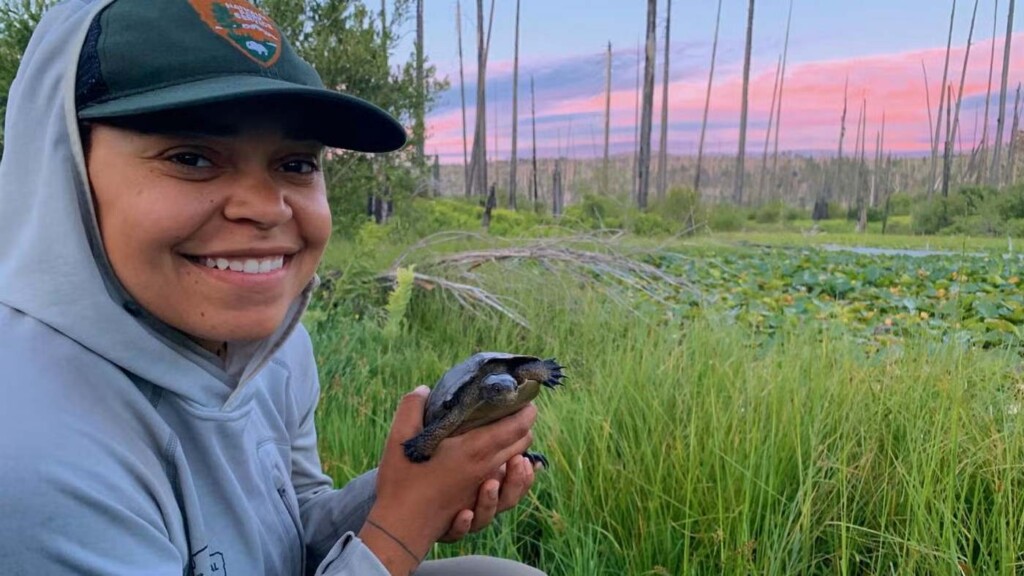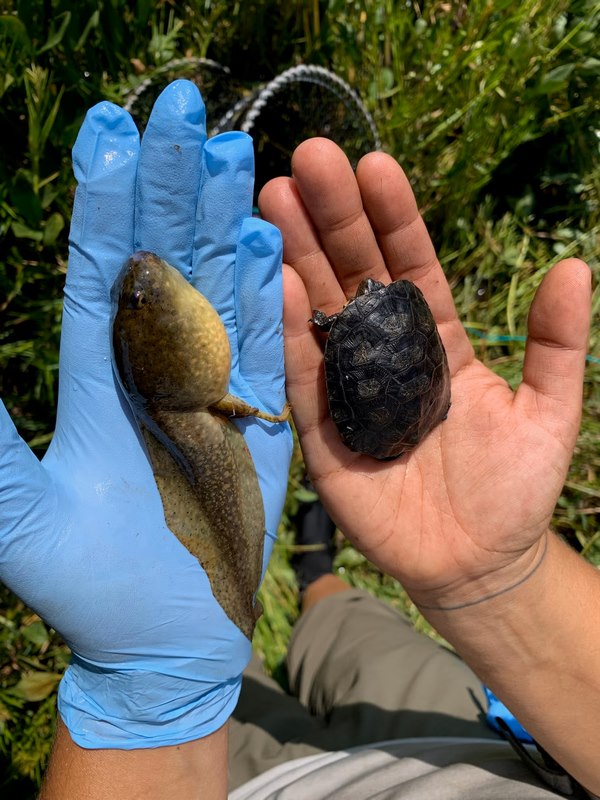 Sidney Woodruff holding a northwestern pond turtle at a field site – credit Sidney Woodruff
Sidney Woodruff holding a northwestern pond turtle at a field site – credit Sidney WoodruffIn Yosemite National Park, the eradication of non-native American bullfrogs has led to the return of California’s only native turtle species.
The northwestern pond turtle has been proposed as a threatened species according to the US Endangered Species List, and their biggest threat is a frog from east of the Rockies.
A UC Davis Ph.D. candidate, Sidney Woodruff, has been conducting research on whether bullfrog elimination could lead to a return of the pond turtle, or if their decline was a multifaceted event.
Between 2016 and 2022, Woodruff chronicled the life and times of bullfrogs and the northwestern pond turtles in four sites inside Yosemite National Park.
Lead author of a study observing and documenting the effects of bullfrog removal, the young scientist has proven conclusively that these big mouthed bullies had to croak before the peaceful turtle can return.
At the start of her research, Woodruff described Yosemite, where the American bullfrog was introduced back in 1950, as so full of the amphibians that “constellations” of eyes would stare back at any light flashed into a pond. Their deafening bullfrog croak was all that could be heard, and more than a few park visitors probably imagined that was normal.
“One reason American bullfrogs are among the top worst globally introduced pests is because they eat everything—anything that fits into their mouth,” said senior author Brian Todd, a UC Davis professor in the Department of Wildlife, Fish and Conservation Biology, a co-author on the paper. “They’ve been causing declines to native species everywhere they’re introduced, which is around the world.”
 Juvenile pond turtle and large American bullfrog tadpole – credit Sidney Woodruff UC Davis
Juvenile pond turtle and large American bullfrog tadpole – credit Sidney Woodruff UC DavisIndeed, the gluttonous frog has been recorded invasively in southern Brazil, northern Colombia, Ecuador, Cuba, Japan, northern Italy, and Malaysian Borneo to name a few locations.
Even before the tadpoles have lost their tails, their mouths are already larger than a juvenile pond turtle. It’s believed they prey on the turtle’s young, as well as newts, salamanders, and other smaller frogs. They’re cold-blooded killers in the most literal sense.
The team undertook searches on foot during the day to locate and scoop bullfrog egg masses using paint strainers or fine mesh nets before laying them out in the sun to dry. Adults were captured at night and euthanized.
INVADERS DEFEATED: Fungus Devastating Frogs Worldwide May Have an Achilles Heel – And it May Save the Amphibians
During the eradication work, the population surveys pointed to a stark reality that if bullfrogs were present, turtles struggled to be. In ponds without bullfrogs, population counts were between twice and 100-times as high as ponds with bullfrogs. In the infested ponds, all observed turtles were large and heavy, suggesting that juveniles were being picked off for the most part.
In fact, it took more than 2 years for the study team to even see a juvenile turtle in a bullfrog-present pond that wasn’t recovered from a frog’s stomach—and that one only after bullfrogs were eradicated, highlighting the scant survival rate they would have suffered from.
THE SUCCESS OF SPECIES ERADICATION: Out-of-Control Invasive Crab Species Has Met its Match: Cute and Hungry Otters
“As bullfrog presence declined, we started to hear other native frogs call and see native salamanders walking around,” Woodruff said of their field work. “It’s nice to be able to go back to these sites and hear a chorus of native frogs calling again that previously would not have been heard.”
Todd told UC Davis Press that all across the state, the only freshwater turtles that should be there are the northwestern pond turtle, and without them, the state would lose “part of our natural heritage.”
HOP Over To Your Friends Social Media And Give Them A Croak About This News…
Source link

